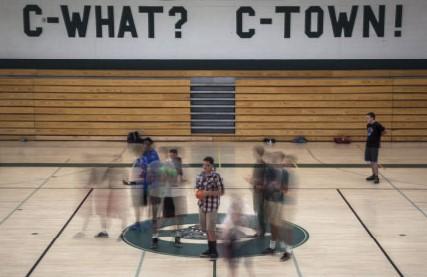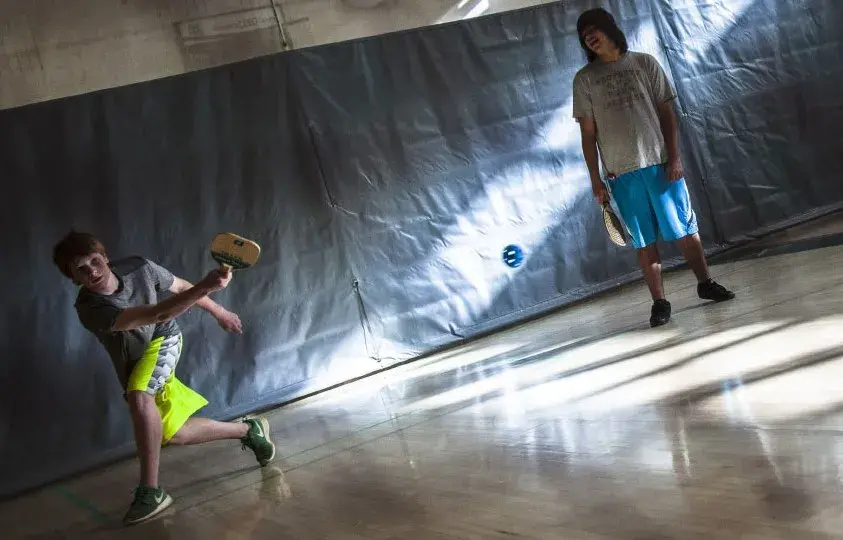Conifer High School physical education instructor Jeanie Boymel told the kids in her morning PE class to grab pedometers, as usual. But then she alerted them to be ready for an out-of-the-ordinary workout, beyond the typical indoor and outdoor activities and sports.
“Today’s activity is ‘Can you make it as a Marine?,’” she told the students. “The Marines are coming in.”
A Marine sergeant stood ready to lead a “boot camp” to give the kids an endurance workout. The nearly 30 boys and girls snatched pedometers from a plastic box on the floor, attached them to their shorts and were soon running as well as doing pushups, squats and other activities.
It’s part of a plan. Jeffco Public Schools is wagering that a combination of technology – in this case, pedometers and computers – physical activity and fitness will build stronger bodies and minds. The state’s second largest school district recently introduced its SPARK Initiative to encourage kids to engage in greater physical activity during PE and special before-school programs.
“Physical activity does improve learning,” said Emily O’Winter, healthy schools coordinator for Jeffco schools.
A lot of people blame technology for the obesity problem we have. I also think it could be part of the solution.
Can making exercise fun with the use of technology improve fitness and, in the case of Jeffco, grades? It’s a question playing out in Colorado and across the nation amid a proliferation of exercise and fitness apps like Fitbit and Zombies, Run! A growing number of these apps use games to increase physical activity – hence the expression the “gamification” of fitness.
Results are mixed. But advocates contend the idea holds promise.
“A lot of people blame technology for the obesity problem we have,” said Ted Vickey, senior consultant on fitness technology at the San Diego-based American College on Exercise, the largest national nonprofit promoting health and fitness. “I also think it could be part of the solution.”
That’s the belief in Jeffco schools, which introduced its SPARK Initiative at five schools in the spring of 2012. Fourteen participate today. SPARK is a national initiative creating and disseminating integrated PE curricula at all ages and following up with research on the program’s effectiveness.
TAll Jeffco elementary schools teach PE one-third of the year, typically every third day. There is no across-the-board PE requirement at Jeffco middle schools; some schools require it while others offer it as an elective. High school students are required to complete a semester of PE or health to graduate. Waivers are allowed, but the use varies among schools.
Under the program, students are fitted with pedometers. They are enrolled in a physical activity class in which they participate in 20- plus minutes of moderate to vigorous physical activity. So-called MVPA is considered 120 steps a minute. Afterward, the students insert their pedometers into docking stations that record their MVPA numbers in a computer database.
In some cases, the students’ schedules are adjusted so that the class directly following the SPARK activity is language arts or math – the hope being that students will be energized, focused and better prepared to learn in these classes.
O’Winter noted that research has demonstrated that exercise helps the brain in several ways, including increased brain cell growth, fewer behavioral problems, improved attention and lower stress by way of a decrease in cortisol.
“True hard science has shown that physical activity can impact indicators of academic achievement,” O’Winter added.
Based on an unscientific sampling of Conifer students, the results are mixed.
“My grades have improved a lot,” said Chris Murphy, a junior. This is his third year in the SPARK Initiative. He flunked three classes during his freshman year and one in his sophomore year. Currently, he is pulling up the one F he has had so far this year.
“It helps me stay awake and stay focused,” Murphy added.
But sophomore Tyler Schoder doesn’t think the added activity has translated into higher grades.
“It doesn’t seem to help me in class,” he said. “I’m getting the same grades as in middle school, and I didn’t take gym in middle school.”
Through the use of pedometers and computer technology, Jeffco is compiling more complete data to match students’ level of physical activity with their academic performance and behavior.
The SPARK Initiative is based on the work of Harvard psychiatry professor John Ratey, who authored the 2008 book “Spark: The Revolutionary New Science of Exercise and the Brain.”
According to the school system, preliminary findings show that exercise promotes:
- Increases in letter grades, test scores and homework completion.
- More engagement and participation in class.
- Positive interactions and relationship building with peers and/or teachers.
- A belief among students in their ability to complete tasks.
“A fast-paced workout boosts the production of a protein called brain-derived neurotrophic factor,” Ratey told USA Today in a 2008 interview. “I call it Miracle-Gro for the brain, and physical activity is one of the best ways to release this brain-nourishing protein.”
Jeffco isn’t the only district taking such an approach. In the St. Vrain Valley School District north of metro Denver, Red Hawk Elementary built physical activity into its plan from day one. Using a rotating daily “movement calendar,” students gain 40 minutes of moderate to vigorous activity on a daily basis – on top of PE class and recess.
Near Chicago, the high-achieving Naperville Community Unit School District spearheaded several PE practices Ratey advocates – and has garnered publicity for the effort.
These approaches dovetail with the explosion in tens of thousands of health and fitness apps on the market today.
But do they work?
Researchers at Brigham Young University set out to answer that question in a study that appeared in the Journal of Medical Internet Research.
“It’s just been assumed that gamified apps will work, but there has been no research to show that they’re effective for people long term,” Cameron Lister, lead author of the study, said in a news release. Lister and a colleague studied more than 2,000 health and fitness apps and found most of the popular ones relied on gaming.

After downloading more than 100 apps and using them personally, the researchers remained concerned that rather than motivate people, gamification could do just the opposite over the long run – because it doesn’t focus on actually changing people’s behavior. Instead, it merely offers users short-term rewards such as digital badges.
“It’s like people assuming that you hate health and you hate taking care of your body so they offer to give you some stuff in order for you to do what they want you to do,” Lister said in the news release. “But really, you should intrinsically want to be healthy and be engaged in healthy activity.”
Similarly, a 2009 study from the American Council on Exercise found that the fitness benefits of Nintendo’s Wii Fit “revealed underwhelming results, with the exercise intensity of most exercises proving to be milder than expected.”
Findings like those may give pause to some PE advocates who would like to see greater use of technology in fitness. At the same time, early results from Jeffco’s SPARK Initiative are encouraging – although more detailed data will be needed for a thorough evaluation.
Either way, new ideas are being employed to get all ages to be more physically active. Back in Jeffco, O’Winter agreed that it’s good to get creative when it comes to promoting physical activity. “We’re excited to do what it takes,” she said. “We just want to get kids moving – that’s my bottom line.”
This article was originally published in the Winter 2015 issue of Health Elevations.

